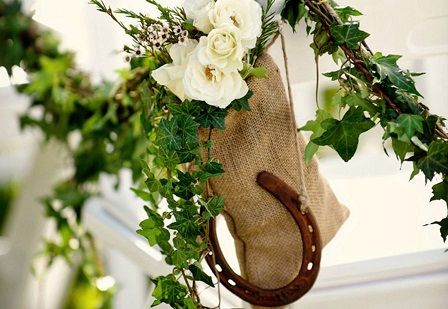 Whether or not you consider yourself to be a superstitious person, there is nothing wrong with hoping for a bit of good luck on the day of your wedding. For as long as marriage has been around, brides and grooms have been engaging in all kinds of practical and bizarre rituals in order to obtain good luck and favorable omens on their wedding days. Though there might not be a ton of scientific evidence to back these practices, there is something to say about the psychological impact of engaging with good luck rituals.
Whether or not you consider yourself to be a superstitious person, there is nothing wrong with hoping for a bit of good luck on the day of your wedding. For as long as marriage has been around, brides and grooms have been engaging in all kinds of practical and bizarre rituals in order to obtain good luck and favorable omens on their wedding days. Though there might not be a ton of scientific evidence to back these practices, there is something to say about the psychological impact of engaging with good luck rituals.
The old adage of “fake it ‘til you make it” can be important to remember here. Practices that promise good luck might not be able to guarantee a wedding without problems, but feeling a sense of confidence can be incredibly helpful. If you think you might be able to benefit from increasing the good vibes surrounding your wedding, take a look at some of these interesting customs from all over the world meant to boost luck before a marriage.
Alanis Morissette’s Folly
Canadian alt-rock singer Alanis Morissette has had a number of successful songs over the years. Still, “Ironic” remains one of the most-discussed tunes in her repertoire. Though discussions generally center around Morissette’s use of the word “ironic,” she also makes a general assumption about rain on a wedding day. The context of the song implies rain is universally a bummer on this particular day. Now, according to certain Hindu customs, the exact opposite is believed to be true. While you might think rain is a force destined to ruin your photos, Hindu tradition suggests something more symbolic.
One common euphemism for marriage is “tying the knot.” On a literal level, when a rope is tied into a knot, the goal is to keep the knot as secure as possible. Should the rope and the knot become wet, it will be much more difficult to undo. On a more metaphorical level, Hindu custom suggests looking at rain on a wedding day as a sign of good fortune for a couple. The rain will help to strengthen the bond between partners, keeping the knot as secure as possible for all of the unseen storms on the horizon.
Trick or Treat?
Going door to door to collect presents is a tradition most people associate with Halloween. In Finnish tradition, however, it is the bride who gets the opportunity to walk around her community and request gifts from her friends and neighbors. Though the origins of this custom are difficult to trace back, the general idea is to increase the amount of luck a couple will have in married life. The more gifts a bride obtains, the more luck will accrue. The groom does not partake in this tradition, though another person is present for the bride’s excursion.
According to tradition, it is typical for an older male relative or friend to accompany the bride. The man will carry an umbrella or similar covering and hold it over the bride as she moves about the area, regardless of the weather. The age of the man is meant to represent the wish for a marriage to have many years. The act of covering the bride symbolizes protection and help, which is said to increase the strength of the coming union. While this is a sweet tradition, you might not want to practice it yourself without warning your neighbors.
When in Rome…
Finally, glimpsing back at traditions of the past might help you appreciate the era in which you were born. According to Ancient Roman custom, couples planning on getting married would have to visit a professional and “read” pig entrails in order to determine the luckiest time for the ceremony.
Good fortune can seem random at times. If you want a little extra luck for your special day, take a look at what customs give you the best sense of comfort.
Add Your Comment